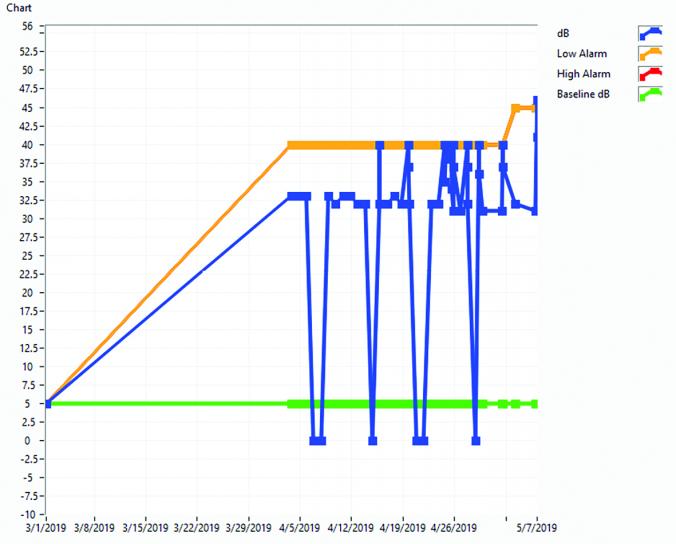The role of ultrasound in Maintenance 4.0 – Enabling Predictive Maintenance
Industry 4.0, the ongoing digital transformation of manufacturing, emphasizes intelligent machines, data-driven decision-making, and interconnected operations. Maintenance 4.0 will be a fundamental part of this revolution and maintenance teams will need to shift from reactive maintenance (fixing problems after they occur) to predictive maintenance (anticipating and preventing failures). We will take a close look at how ultrasound sensors and data-collection instruments will play a key role in this shift to Maintenance 4.0.

Maintenance 4.0: the role of Ultrasound
In the era of Maintenance 4.0, ultrasound technology emerges as a critical tool for pinpointing equipment health. Ultrasound excels at detecting subtle changes, like increased bearing friction - a telltale sign of bearing wear, bearing damage or even lubrication deficiencies.
By capturing these early warnings, ultrasound empowers proactive maintenance strategies. Technicians can address lubrication issues before they escalate, preventing costly breakdowns and maximizing equipment lifespan.
Ultrasound's Applications and Advantages: Shining a Light on Hidden Issues
Ultrasound proves particularly valuable in several key areas of Maintenance 4.0 and has some unique strenghts:
Bearing Condition Monitoring – Earliest Warning of Failure: Ultrasound effectively identifies bearing wear, lubrication deficiencies and other issues by simply monitoring any increase in friction. This allows for corrective actions before breakdowns occur or even before failure itself.
Optimizing Lubrication: Did you know that 60% to 80% of bearing failures are related to poor lubrication? Ultrasound helps assess lubrication effectiveness, ensuring optimal performance and extending equipment life. Ultrasound instruments will also help maintenance technicians to be sure they apply only the right amount of lubricant, avoiding the very common problem of over-lubrication.
Monitoring Slow Speed Bearings: Traditional vibration analysis often struggles with slow-speed machinery. Since ultrasound will monitor any increase in friction, it is very effective in monitoring the health of these critical components.
Using Ultrasound-based solutions for early failure detection: Cases & Examples
Bearing Fatigue Detected in a Flour Milling Plant
A flour milling facility invested in placing ultrasound sensors on multiple critical bearings. The sensors are connected to a data processing unit – called the 4Cast – which then connects to a data management software. This setup makes it possible for the maintenance team to be notified via email or SMS as soon as the 4Cast detects that a certain bearing has reached an alarm level – it is possible to setup low level and high level alarms.
Because the idea was to monitor critical bearings, the maintenance team decided to let the system warn them as soon as a low alarm level is achieved. We can see in this image how the dB readings from this bearing, belonging to a sifter, kept hitting the low alarm and would not stay below the baseline level. The team decided to take a better look into the sound file from this bearing, and this is how it looked like.
When compared to a sound recording from a bearing whose readings were according to baseline, it became very clear that the bearing had some sort of defect. Notice the difference in amplitude between the spectrum of these sound files. The team decided to tear the 35 cm. bearing apart to confirm the damage, finding clear signs of bearing fatigue, observed in both the outer race and the rolling elements.
Critical bearing failure at a pulp and paper plant
Usually, in pulp and paper plants we will find a wash floor or wash area, where the paper comes through to be thoroughly cleaned / bleached. That job is done by a machine called a bleach decker, which is considered a critical and fundamental piece of equipment for production operations.
In this particular plant, which has a predictive maintenance program in place, it was decided to invest in online monitoring for these machines, using ultrasound sensors. This machine has 4 bearings, of about 120 cm diameter, rotating at 3 RPM.
The online monitoring system (4Cast) received an unusual decibel reading from one of the ultrasonic sensors. The NDE (non-drive-end) bearing of this bleach decker was registering 17dB when, normally, a bearing rotating at such slow speeds like 3RPM should simply show a 0dB reading.
This triggered the system to immediately alert the maintenance team. In this case, and even though the machine was apparently working as expected, the sound file spectrum showed a very different story.
peaks shown in this sound sample clearly indicate a problem with the bearing. Also, when reproducing the sound file, we could very clearly hear the impact noises. The failure was even more obvious when the sound file was compared to a sound recording from one of the other bearings.
When the bearing was dismantled, the damage was clearly visible. The signs of impact are obvious. Also, metal fragments were found in the shaft, plus spalling, with some pitting, and slight abrasion were present in the outer race.















